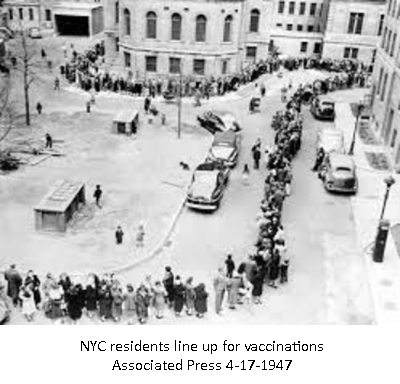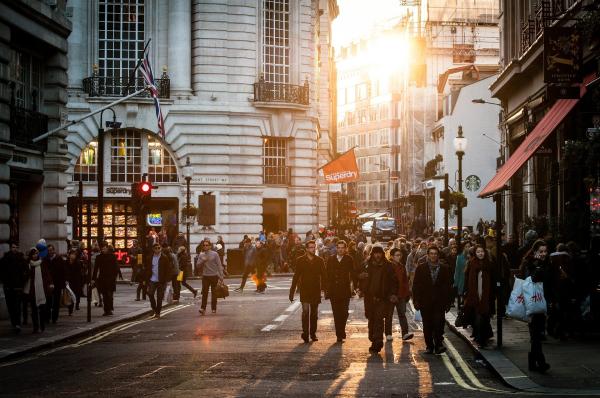Smallpox in the Big Apple
Once the diagnosis was confirmed, New York City’s Mayor, William O’Dwyer, reacted quickly, issuing an appeal for universal vaccination. His constituents responded immediately. In the space of two weeks, five million people were vaccinated, two and a half million in the first week alone. In less than a month, more than 84% of  the City’s population of 7,500,000 were vaccinated. There were no lawsuits, no riots, no opposition. People quietly and courteously lined up to be vaccinated. A month later, the epidemic was declared over.
the City’s population of 7,500,000 were vaccinated. There were no lawsuits, no riots, no opposition. People quietly and courteously lined up to be vaccinated. A month later, the epidemic was declared over.
Maybe the Jacobson case from Massachusetts forty years prior had primed the populace. Maybe people were war-weary. Maybe the health commissioner, Dr. Israel Weinstein, and his daily radio programs, were better at risk-communication than we are now. Maybe people were freaked out. Maybe there were no organized anti-vax groups spouting propaganda or groups urging personal choice, stoking the populace?
It wasn’t because the vaccine was readily available. At the time the campaign was announced, there were 250,000 doses on hand. O’Dwyer pressured vaccine manufacturers to step-up-to-the plate and expedite vaccine production. More than 1000 physicians, 242 clerks, and 3,000 civilian volunteers did the vaccinating, while NYC’s finest supervised the long lines snaking around vaccine centers. All the while, Dr. Weinstein calmly countered the hysterical media in his daily radio broadcasts[BB2]
It wasn’t because the smallpox vaccine was especially safe. That vaccine is one of the most dangerous vaccines made. Because of the manner of its formulation and its long history of tetanus-causing contamination., people were genuinely and validly frightened [1]. When 500,000 smallpox vaccines were allocated to the CDC in 2003 for first responders in the wake of Saddam’s alleged production of a smallpox bioweapon, the[BB3] uptake was minimal; only 38,000 volunteered in the first eight months. Fear of the vaccine coupled with the low likelihood that such a weapon would ever materialize drove that wave of vaccine refusal. A New England Journal of Medicine article confirmed the low risk-benefit ratio of vaccinating the general public from a terrorist attack.
Yet, the reaction after the smallpox virus actually made landfall in New York in 1947 was swift, silent, and orderly. Vaccine uptake was high enough to provide herd immunity.
Smallpox Vaccine Fallout
By the time the epidemic was declared over
- Twelve people had contracted the disease; two had died. The case fatality was 16%, half the conventionally given number.
- Three people died of the vaccine; three more died from direct vaccine-related complications, for a total of six vaccine deaths. Another six died of probable vaccine-related encephalitis. No one cried foul. No one sued (at least to the best of my knowledge).
Polio
There was a similar experience with the polio vaccines, both Salk and Sabin. Here, too, the uptake was eager and accepted. Here, too, the vaccines were not completely benign. Here, too, there were instances of contamination. Yet, even at the experimental states, people rushed to have their children inoculated:
“in 1954 … frantic American parents — looking for anything that could beat back the horror of polio — offered up more than 1.8 million children to serve as test subjects. They included 600,000 kids who would be injected with either a new polio vaccine or a placebo…. 443,000 children received at least one polio inoculation, while more than 210,000 received a placebo….”
There was no vaccine resistance. There were no concerns about autism. But then, there was no Andrew Wakefield spewing false associations of the vaccine with autism. Nor was there RFK Jr. spouting that vaccines do not prevent disease.
So, what’s the difference between then and now?
“One reason, historians say, is that in 1955, many Americans had an especially deep respect for science.”
One reason might have been greater forthcomingness and honesty. Even mishaps in vaccine manufacturing did not diminish the parent’s trust in the vaccine, the program, or the leaders of the vaccination program. That trust must have been huge:
In 1955, 200,000 children received a defective polio vaccine when live virus was mistakenly used instead of the killed virus specified. Forty thousand got polio; 200 were left with paralysis; ten died. Nevertheless, even afterward, mothers and fathers jumped right back in, once again signing permission slips and lining their kids up to get their polio shot.
One reason might have been rank terror. Smallpox conjured horrors of a physically disgusting disease. And while American epidemics since the turn of the last century were far less lethal than previously, the mythic mantra of a 30% smallpox case-fatality rate remains embedded in the American medical literature [2]. Polio left some of its survivors paralyzed or disabled. The grossly unattractive physical remnants of both diseases were obvious. People did what they could to avoid them – lockdowns were voluntarily implemented:
As [polio] outbreaks popped up across the country in the hot summer months, people were terrified and voluntarily isolated…."Back then, it affected business and travel," says Stacey D. Stewart, current president and CEO of the March of Dimes. "People didn't know how the virus was transmitted. They lived in a state of fear. Pools were closed. Businesses were affected because people didn't want to be out in public."
Perhaps it’s because the anti-vaxxers have taken control of the public relations campaign. Their message: fear the vaccine; don’t fear vaccine-preventable diseases, be they COVID or measles, they aren’t dangerous, and above all, don’t trust the evil pharmaceutical industry or the duplicitous government.
Perhaps, there is a false sense of invulnerability, an arrogant assumption of invincibility, or a legitimate but greater dependence on economic grease for survival compared to 75 years ago. In the middle of the last century, polio disabled an average of 35,000 people a year in the U.S., mostly children. In 1952, the peak year, 3000 children died. So far, COVID has claimed the lives of 680,000 Americans. This chilling statistic doesn’t seem to move either the rank anti-vaxxers or their deceptively disarming allies who extoll individual freedom as a basis to resist public health measures and vaccine mandates, all the while proclaiming their support of vaccination.
Perhaps today, legitimately, people are more mistrusting of government. The organized anti-vax movement seems to have found rich (unwitting) allies, augmenting their coffers, power, and reach. Destabilizing groups falsely urge the assumption of autonomy, personal control, and unlimited personal freedom to reject vaccines even when the health of others is at stake. Others, seemingly pro-vaccines, reject governmental intercession as a matter of principle, even when vaccine mandates may be our only alternative.
Most (maybe all) public health lawyers, myself included, would prefer that vaccine mandates or compelled vaccination would never be needed. In our past, that was sometimes the case, but maybe today, we need more public health tools in our arsenal.
Ideologies can be noble. But survival is necessary. Sometimes we must sacrifice our lives for our beliefs. But sometimes, we must sacrifice our beliefs to live, to fight again another day. The crux of wisdom is determining which is time is now. It used to be that science helped answer the questions. No longer, it seems.
[1] Michael Willrich, Pox (2011)
[2] Harrison’s Textbook of Internal Medicine in 1970 noted the case-fatality of smallpox was 20%
Additional Sources: Weapons of Mass Hysteria, Faulty Biothreat Predictions, and Their Impact on National (In)Security: A Case-Study of Smallpox, Health Matrix Journal of Law-Medicine (2017)




